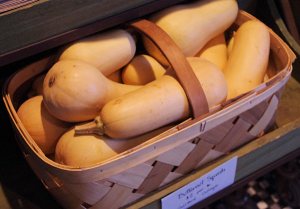Butternut Squash and the Three Sisters approach to succotash
LOCAVORE’S DELIGHT: The Series #24. Follow us as we explore the bounty of our region’s farms.
In Native American lore, three crops were always planted together: squash, corn, and beans. Legumes would wind their way up the corn and use the stalk as a trellis, and the squash would grow between the rows, under the shade of the corn.
Much of what we do here at Lucky 32 Southern Kitchen is recover traditions that are in danger of being lost. While different people have different opinions about succotash and its contents, we base our recipe on the Ancient Three Sisters model — and at the heart of our succotash is butternut squash.
This time of year, it’s not uncommon to see a harvested field with the corn stalks cut and butternut squash still curing on the vine. Our fall menu features the nutty-flavored winter cucurbit in the butternut squash soup. You can also find them in the Farmer’s Cart at the restaurant.
Fall for Something New! features Lucky 32 Southern Kitchen’s Butternut Squash soup, October 3–November 13, 2012. Click here to see the new fall menu.

One tough vegetable
We often joke that only three things are not allowed in this kitchen: Monkfish (we can’t cook it properly), mustard greens, and acorn squash.
Acorn squash doesn’t give you any more flavor than butternut squash, and it’s much harder to clean with its thick ridges. Butternut squash gives you a better meat-to-skin ratio and has a wonderful nutty flavor, and it’s easy to work with.
The cure: Conversations with farmers will teach you things
Tobacco gets cured. Sweet potatoes get cured, and we’ve known both of those things, but we didn’t know that winter squash gets cured, too.
Curing is a heating process, to encourage the starch to sugar conversion. The process prevents spoilage and allows for longer storage.
The way we’ve heard it it told is that butternut squash needs to be planted at the same time as summer squash. Farmers leave it in the field and the sun heats up the squash. After a certain number of days in the field the vegetable is cured and you can put them in the cellar for the winter.
Take it home: Lucky 32 Southern Kitchen’s Butternut Squash Bisque recipe in Savor NC.
The most popular winter squash
- Acorn
- Butternut
- Pumpkin
Some less popular, but even more tasty
Easy ways to prepare butternut squash:
Roast and finish with butter and cinnamon
- Pick one squash, about two lbs.
- Split the squash from north to south, through the stem; scoop out the seeds.
- Lay it out cut side down on a greased baking tray.
- Roast until it’s tender to a finger poke (at 350 degrees for for 35 minutes-ish).
- Remove the squash from the oven.
- Flip it over.
- If the squash is small enough, put a little butter and cinnamon in the hole and take a scoop and drag it through the hole and eat it.
Braise with a little butter
- Clean and peel entire squash with a vegetable peeler.
- Cut the bell part out of the base.
- Scoop the seeds out.
- Cube it.
- Sauté it with butter and braise with a little water, to steam.
Do you puree?
Once it’s roasted and flipped, scrape all the flesh out of the skin, and puree with butter, sorghum, and call it a day.
Squash the bread
Substitute butternut squash to change up your favorite sweet potato recipe. Or, substitute equal amount of roasted butternut squash for the main vegetable in any one of your favorite bread or muffin recipes.
- Zucchini
- Banana
- Pumpkin
Pick the perfect squash
Pick up a few butternut squashes and compare the weight. The one that feels heavier for its size is going to have a smaller cavity, fewer seeds and more dense fruit, and generally has a higher sugar content.
- Heavy for its size
- Unblemished skin
A word to the unripe
If you go to peel your squash and it has some green undertones to its skin, then it hasn’t been cured long enough. At this point, it won’t get more ripe. It won’t be as sweet and will taste more like a vegetable.
Give it a try: Lucky 32 Southern Kitchen Autumn Succotash. Tweet this recipe.
Sauté the butternut squash as recommended above. And you can also replace the peanuts with crowder peas or black eyed peas.
Makes 4 cups
- ¼ cup butter
- 1 lb. butternut squash, washed, peeled, and diced
- ½ lb. boiled peanuts
- ½ lb. sweet corn ears, kernels cut from cobs
- ¼ cup water
- ½ tsp. dried thyme
- Salt and pepper to taste
Melt butter in a skillet over medium-high heat. Add butternut squash, and sauté 3 to 4 minutes. Add boiled peanuts, and cook 3 to 4 minutes. Add corn kernels and remaining ingredients. Cook until corn, peanuts, and squash are tender. Cover and cook 6-8 minutes (or until squash is tender).
For more about our seasonal recipes, see our current menu at Lucky 32 Southern Kitchen and our Blog Recipe Index:http://lucky32southernkitchen.com/recipes/









